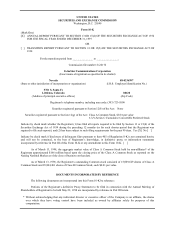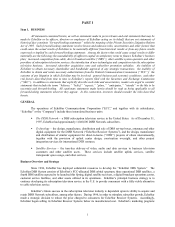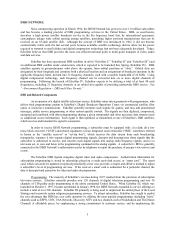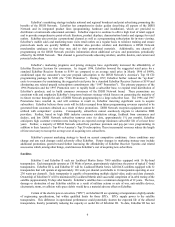Dish Network 1997 Annual Report Download - page 8
Download and view the complete annual report
Please find page 8 of the 1997 Dish Network annual report below. You can navigate through the pages in the report by either clicking on the pages listed below, or by using the keyword search tool below to find specific information within the annual report.6
EchoStar’s marketing strategy includes national and regional broadcast and print advertising promoting the
benefits of the DISH Network. EchoStar has comprehensive dealer guides describing all aspects of the DISH
Network and its integrated product lines (programming, hardware and installation), which are provided to
distributors at nationwide educational seminars. EchoStar expects to continue to offer a high level of retail support
and to provide comprehensive point-of-sale literature, product displays, demonstration kiosks and signage for retail
outlets. EchoStar also provides a promotional channel as well as a programming subscription for in-store viewing.
EchoStar’s mobile sales and marketing team visits retail outlets on a regular basis to reinforce training and ensure
point-of-sale needs are quickly fulfilled. EchoStar also provides retailers and distributors a DISH Network
merchandise catalogue so that they may add to their promotional materials. Additionally, one channel of
programming on the DISH Network provides information about additional services and promotions periodically
offered by the DISH Network. That channel is geared towards educating retailers, satellite dealers, and current and
potential subscribers.
EchoStar’s marketing programs and pricing strategies have significantly increased the affordability of
EchoStar Receiver Systems for consumers. In August 1996, EchoStar lowered the suggested retail price for a
standard EchoStar Receiver System to $199 (as compared to an average retail price in March 1996 of $499),
conditioned upon the consumer’s one-year prepaid subscription to the DISH Network’s America’s Top 50 CD
programming package for $300 (the “ 1996 Promotion” ). During 1997, EchoStar further reduced the “ up-front”
costs to consumers by maintaining the suggested retail price for a standard EchoStar Receiver System at $199 and
eliminating any related prepaid subscription commitments (the “ 1997 Promotion”). The primary purposes of the
1996 Promotion and the 1997 Promotion were to rapidly build a subscriber base, to expand retail distribution of
EchoStar’s products, and to build consumer awareness of the DISH Network brand. These promotions are
consistent with and emphasize EchoStar’s long-term business strategy which focuses on generating the majority of
its future revenue through the sale of DISH Network programming to a large subscriber base. The 1996 and 1997
Promotions have resulted in, and will continue to result in, EchoStar incurring significant costs to acquire
subscribers. EchoStar believes those costs will be fully recouped from future programming revenues expected to be
generated from customers obtained as a result of these promotions. DISH Network reception equipment cannot be
utilized with competitors’ systems. Consequently, subscribers cannot seamlessly migrate to alternative DBS
providers. Further, based on high DBS industry consumer satisfaction ratings, feedback from consumers and
dealers, and low DISH Network subscriber turnover rates (to date, approximately 1% per month), EchoStar
anticipates high customer retention rates leading to an expected average minimum subscriber life of at least three
years. Further, a majority of DISH Network subscribers purchase premium and pay-per-view programming in
addition to their America’s Top 40 or America’s Top 50 subscription. These incremental revenues reduce the length
of time necessary to recoup the average cost of acquiring new subscribers.
EchoStar’s present marketing strategy is based on current competitive conditions; those conditions may
change and any such changes could adversely affect EchoStar. Future changes in marketing strategy may include
additional promotions geared toward further increasing the affordability of EchoStar Receiver Systems and related
accessories which, among other things, could increase EchoStar’s cost of acquiring new subscribers.
Satellites
EchoStar I and EchoStar II each are Lockheed Martin Series 7000 satellites equipped with 16 Ku-band
transponders. Each transponder operates at 130 Watts of power, approximately eight times the power of typical C-band
transponders. EchoStar III is, and EchoStar IV will be, Lockheed Martin Series A2100AX satellites equipped with 32
transponders that will operate at approximately 120 watts per channel (switchable to 16 transponders operating at over
230 watts per channel). Each transponder is capable of transmitting multiple digital video, audio and data channels.
Ownership of EchoStar IV will be maintained by Lockheed Martin until successful completion of in-orbit testing of the
satellite (approximately 50 days after launch). EchoStar’s satellites have a minimum design life of 12 years. The loss,
damage or destruction of any EchoStar satellite as a result of military actions or acts of war, anti-satellite devices,
electrostatic storm, or collision with space debris would have a material adverse effect on EchoStar.
Certain of the electric power converters (“ EPC” ) on EchoStar III are operating at temperatures slightly outside
of engineering specifications, but within qualified limits for those EPCs. EPCs supply power to the satellite
transponders. This difference in operational performance could potentially shorten the expected life of the affected
transponders, thereby potentially reducing the capacity or useful life of EchoStar III. To date, EchoStar III has not





















